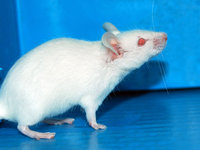Strain Data Sheet
RBRC01459
Strain Information | |
|---|---|
| Image |  |
| BRC No. | RBRC01459 |
| Type | Transgene |
| Species | Mus musculus |
| Strain name | FVB/N-Tg(P0-cre)1Gth/GvnRbrc |
| Former Common name | P0Cre-A |
| H-2 Haplotype | |
| ES Cell line | |
| Background strain | FVB/N |
| Appearance | albino [a/a B/B C/C] |
| Strain development | Developed by Dr. Marco Giovannini at INSERM, France in 2000. P0Cre transgene fragment consisting of P1 Cre recomnbinase and 1.1 kb rat P0 promoter was injected into the pronuclei of FVB/N fertilized egges. |
| Strain description | FVB/N-Tg(P0-Cre)1Gth. P0Cre contains a transcriptional unit consisting of a Schwann cell specific promoter (myelin protein zero promoter) and Cre recombinase gene. This strain can be used to make a inducible knock-out by crossing with other conditional knock out mice that have floxed genes. P0Cre is a driver mouse that can remove floxed genes only in the myelin of the PNS. |
| Colony maintenance | Sibling Mating |
| References | Conditional biallelic Nf2 mutation in the mouse promotes manifestations of human neurofibromatosis type 2. Giovannini M, Robanus-Maandag E, van der Valk M, Niwa-Kawakita M, Abramowski V, Goutebroze L, Woodruff J M, Berns A, Thomas G Genes Dev., 14, 1617-1630 (2000). 10887156 |
Health Report | |
|---|---|
| Examination Date / Room / Rack | 2025/06/09Room:3-6Rack:BSentinel mouse program 2025/03/10Room:3-6Rack:BSentinel mouse program 2024/12/09Room:3-6Rack:BSentinel mouse program 2024/09/09Room:3-3Rack:BSentinel mouse program |
Gene | |||||||
|---|---|---|---|---|---|---|---|
| Gene Symbol | Gene Name | Chr. | Allele Symbol | Allele Name | Common Names | Promoter | Diseases Related to This Gene |
| cre | Phage P1 Cre recombinase | UN | cre | rat P0 promoter, rabbit beta-globin intron and polyadenylation signal | |||
| nls | SV40 large T antigen nuclear localization signal (NLS) | UN | nls | ||||
Phenotype | |
|---|---|
| Phenotype annotation from literatures by Mammalian phenotype ontology | |
| Detailed phenotype data | |
Ordering Information | |
|---|---|
| Donor DNA | rat P0 promoter, Simian virus 40 Large T antigen nuclear localization signal (nls), Phage P1 Cre recombinase, rabbit beta-globin intron and polyadenylation signal |
| Research application | Cre/loxP system Cre driver |
| Specific Term and Conditions | In publishing the research results obtained by use of the BIOLOGICAL RESOURCE, a citation of the following literature(s) designated by the DEPOSITOR is requested. Genes Dev., 14, 1617-1630 (2000). In publishing the research results to be obtained by use of the BIOLOGICAL RESOURCE, an acknowledgment to the DEPOSITOR is requested. RECIPIENT shall keep DEPOSITOR apprised of any results obtained from the BIOLOGICAL RESOURCE in the course of the research, as soon as they are available. Moreover, if the research results in a potential invention or a substance that may have potential commercial value (hereinafter referred as to the "Invention") RECIPIENT will promptly disclose this Invention to DEPOSITOR with samples thereof for DEPOSITOR's internal use. RECIPIENT and DEPOSITOR will consult together and agree about the possibility of filing one or more patent application to Invention conceived by one or more employees of Recipients that directly arise out of the research. The Parties will negotiate in good faith the conditions of such patent application according to each party's inventiveness contribution in the Invention. In case of such Invention, patentable or not, reduced in practice or developed in the course of the research that could not have been obtained, reduced to practice or developed but from using the Material and/or Confidential Information, RECIPIENT and DEPOSITOR shall confer with one another as regards licensing and commercialization of such Invention to negotiate in good faith the terms of an institutional agreement as regards said matters. |
| Depositor | Marco Giovannini (INSERM) |
| Strain Status |  Live mice Live mice Frozen embryos Frozen embryos Frozen sperm Frozen sperm |
| Strain Availability | Recovered litters from cryopreserved embryos (2 to 4 months) Cryopreserved sperm (within 1 month) Cryopreserved embryos (within 1 month) |
| Additional Info. | Necessary documents for ordering:
Genotyping protocol -PCR- |
BRC mice in Publications |
|---|
Ogawa Y, Eto A, Miyake C, Tsuchida N, Miyake H, Takaku Y, Hagiwara H, Oishi K. Induced Pluripotent Stem Cells Generated from P0-Cre;Z/EG Transgenic Mice. PLoS One 10(9) e0138620(2015) 26382630 |
Sowa Y, Imura T, Numajiri T, Takeda K, Mabuchi Y, Matsuzaki Y, Nishino K. Adipose stromal cells contain phenotypically distinct adipogenic progenitors derived from neural crest. PLoS One 8(12) e84206(2013) 24391913 |